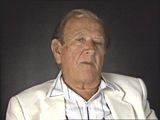

People went in through the gate. Now we know what the gate was, it was the way to the gas chamber and we have never see them again. That was the first hour we came in. After that, we, the people, 18 or 16 people...more people came in from the...working people, they worked already before, in the gas chamber, we had a order to clean up the place. Clean up the place--is not something you can take and clean. It was horrible. But in five, ten minutes this place had to look spotless. And it looked spotless. Like there was never nobody on the place, so the next transport when it comes in, they shouldn't see what's going on. We were cleaning up in the outside. Tell you what mean cleaning up: taking away all the clothes, to those places where the clothes were. Now, not only the clothes, all the papers, all the money, all the, the...whatever somebody had with him. And they had a lot of things with them. Pots and pans they had with them. Other things they had with them. We cleaned that up.
People went in through the gate. Now we know what the gate was, it was the way to the gas chamber and we have never see them again. That was the first hour we came in. After that, we, the people, 18 or 16 people...more people came in from the...working people, they worked already before, in the gas chamber, we had a order to clean up the place. Clean up the place--is not something you can take and clean. It was horrible. But in five, ten minutes this place had to look spotless. And it looked spotless. Like there was never nobody on the place, so the next transport when it comes in, they shouldn't see what's going on. We were cleaning up in the outside. Tell you what mean cleaning up: taking away all the clothes, to those places where the clothes were. Now, not only the clothes, all the papers, all the money, all the, the...whatever somebody had with him. And they had a lot of things with them. Pots and pans they had with them. Other things they had with them. We cleaned that up.
Describes gassing operations at Treblinka
[Interview: 1990]
Abraham was raised in Czestochowa, Poland, and became a barber. He and his family were deported to the Treblinka killing center from the Czestochowa ghetto in 1942. At Treblinka, Abraham was selected for forced labor. He was forced to cut women's hair before they were gassed, and he sorted clothing from arriving transports. Abraham escaped from the camp in 1943 and made his way back to Czestochowa. He worked in a labor camp from June 1943 until liberation by Soviet troops in 1945.
— US Holocaust Memorial Museum - Collections
"Final Solution": Overview »
Final Solution (Abridged Article) »
Gassing Operations »
Gassing Operations (Abridged Article) »
Killing Centers (Abridged Article) »
Killing Centers: An Overview »
Treblinka »
Treblinka (Abridged Article) »